Communications Materials
Appendix A-D SLDS Survey 2020-2022 Communication Materials (1).docx
Statewide Longitudinal Data System (SLDS) Survey 2020-2022
Communications Materials
OMB: 1850-0933
National Center for education statistics
(nces)
Statewide Longitudinal Data System (SLDS) Survey 2020 –2022
OMB# 1850-0933 v.8
Appendices A – D – Contact Materials
January 2020
Appendices included
Introductory Email Script and Instructions
2020 Webinar PowerPoint and Webinar Listserv Invitation
Non-Response Follow-Up Email Script
Non-Response Call Script
APPENDIX A – Introductory Email Script and Instructions

[date 1]
Dear Project Director and/or Primary SLDS Contact:
The National Center for Education Statistics (NCES) has initiated a data collection effort to help inform ongoing evaluation and targeted technical assistance efforts to enrich the quality of the Statewide Longitudinal Data System (SLDS) Program’s support to States regarding system development, enhancement, and use.
This project is a formalized expansion of the SLDS Program’s Interim Progress Report (IPR), which was intended to provide NCES with insight on State and U.S. territory SLDS capacity for automated linking of K-12, teacher, postsecondary, workforce, career and technical education (CTE), adult education, and early childhood data.
To ensure the success of the SLDS Survey, we need your help. Included in this email is this link to the online SLDS Survey and an attachment with the completion instructions. We encourage all respondents to complete the online version to ease both completion and analysis time. Should you have issues accessing or completing the online version of the Survey, please do not hesitate to contact us. We will accept completed surveys via email until the deadline of [date2].
By providing NCES with information regarding the capacity of your State’s SLDS, NCES will be able to provide a publically-accessible set of metrics and use cases showing data-linking and use capacity by State in the form of an IES-approved Statistics in Brief, which will enable interested users to quickly ascertain which States have capacity to link data across sectors. For example, which States can link K12, postsecondary, and workforce data, and how they are using these data to inform policy and practice. We also will use the data collected from the Survey to respond to questions from internal and external stakeholders regarding SLDS capacity in the States, and to inform future grant rounds and technical assistance planning.
The cooperation of your State is important to the success of this national survey of SLDS capacity. NCES will not sell these data and will notify you when the public metrics and use cases become available, in the form of an IES Statistics in Brief. The Survey data will be collected on an annual basis. SLDS system capacity changes frequently (ex. Infrastructure enhancements, evolving P20W agency collaborations, State legislation impacts, etc.), so collecting data less often would make the information too obsolete to be useful for targeted technical assistance planning.
If you have questions about the SLDS Survey, please contact Kristen King at [email protected].
Sincerely,
Ross Santy
Associate Commissioner, Administrative Data Division
National Center for Education Statistics
Institute of Education Sciences
APPENDIX A – Introductory Email Script and Instructions
(An updated version with accurate dates and links to the new Google Form information collection tool may be included in the post-clearance change request, estimated for late Spring 2020)
[Email Attachment]
Instructions:
Please complete the SLDS Survey within the new Google Form information collection tool , based on the current status of each specified element or capability in your SLDS, not the status of elements or capabilities of systems that are not linked to your SLDS. While we recognize there are various levels of linking, when we use the term “link”, we are referring to an established technology solution that allows for data to be brought together in a replicable and useful way.
If your state has or is in the process of building more than one SLDS (e.g., K12 and P20W), your responses should reflect the cumulative status and attributes encompassing both systems. A P20W system encompasses information across multiple sectors. It is inclusive of not only K12 data, but could include early learning, postsecondary, and/or workforce data. Therefore, you may have to consult other state agency or department counterparts to complete this Survey in its entirety (early learning, postsecondary, workforce, etc.) The data that are collected inform our on-going evaluation and technical assistance efforts, and might be used to assess state needs to guide future grant round agendas. Thank you for completing this Survey with accurate responses.
The feature status options are:
Not Planned - The state is currently not planning to include that element/capability in its SLDS. “Not Planned” should also be marked for items that are not applicable to your state SLDS at this time (legislative prohibitions, “unadopted” interest, etc.);
Planned - The state intends to include this element/capability in its SLDS and has a documented plan and
funding source to implement, but implementation work has not begun;
In Progress - The state is currently building or implementing this element/capability as part of its SLDS, but it is not yet fully operational; and
Operational - This element/capability is fully functional and available for its intended users.
The SLDS Survey has been prepopulated with your State’s most recent responses from the previous collection. Should you have issues accessing or completing the online version of the Survey, please do not hesitate to contact us.
Kristen King
APPENDIX B – 2020 Webinar PowerPoint and Webinar Listerserv Invitation
(Below is the version for 2019. An updated version with accurate dates and screenshots of the new Google Form information collection tool will be included in the post-clearance change request, estimated for late Spring 2020.)
[Webinar]
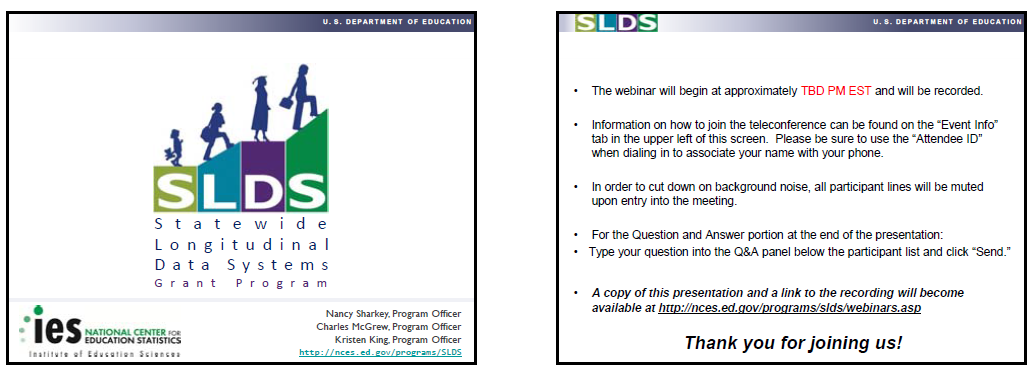
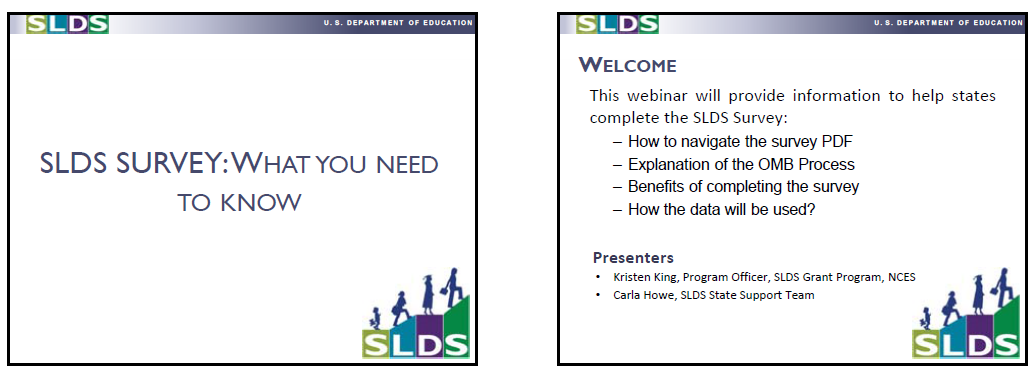
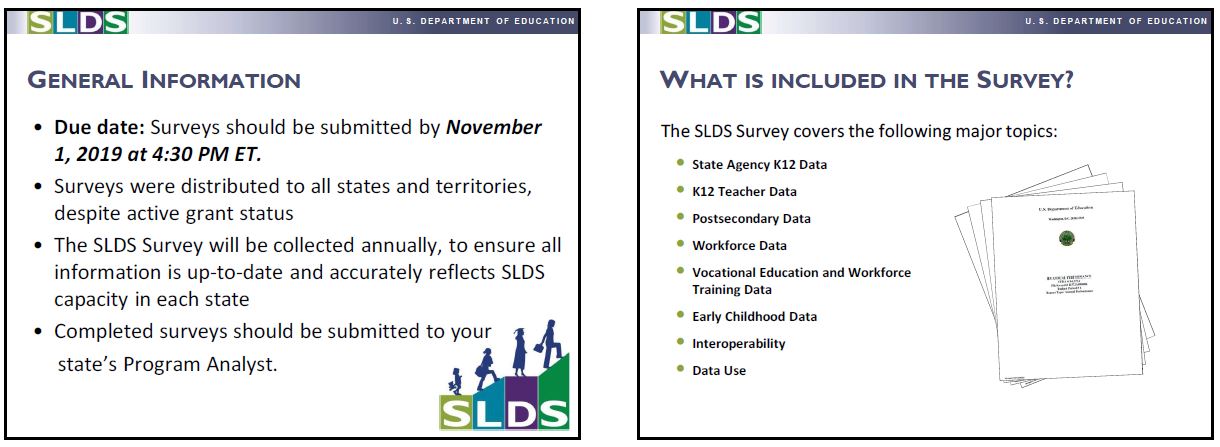
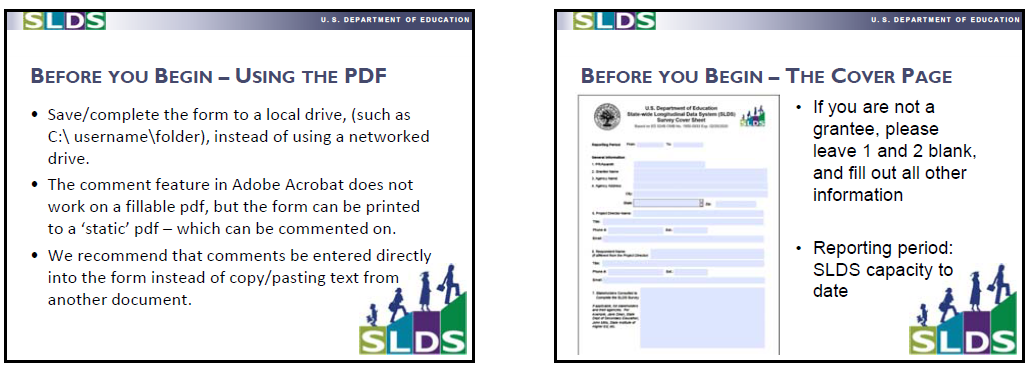
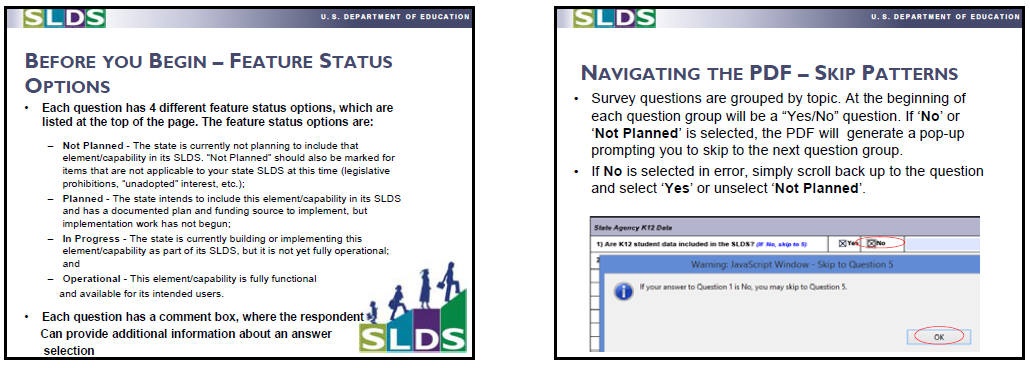
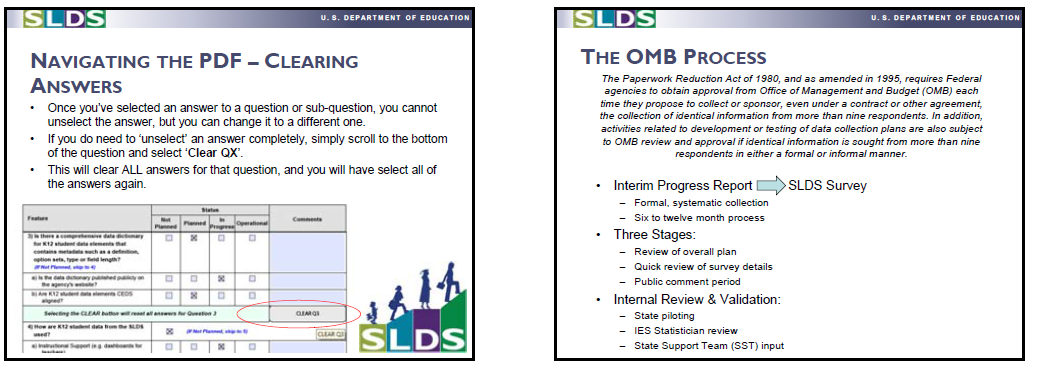
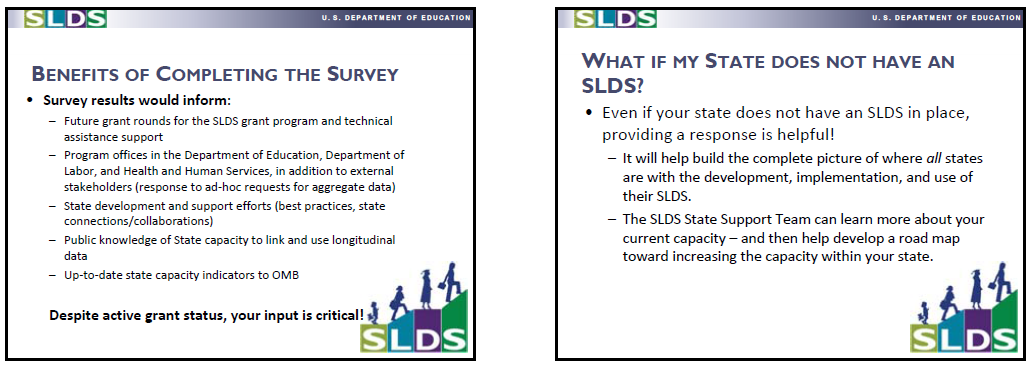
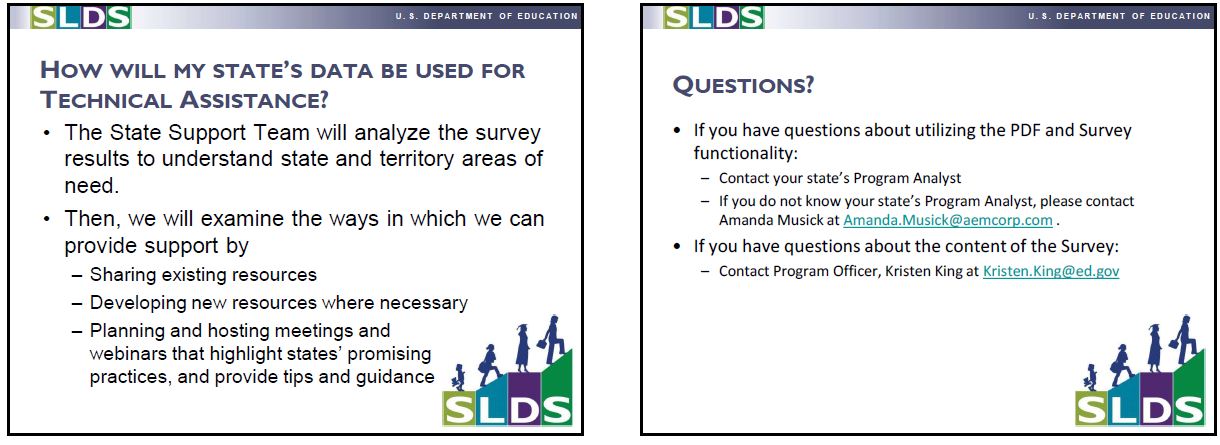
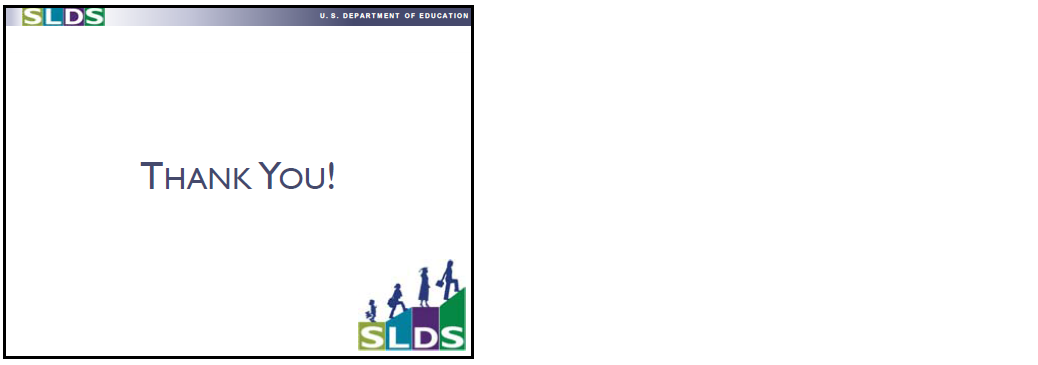
APPENDIX B – Webinar PowerPoint and Webinar Listserv Invitation
[Listserv Announcement]
Please join the SLDS Program on Weekday, Month Day at Xpm ET for a webinar explaining the official SLDS Survey.
The National Center for Education Statistics (NCES) has initiated a data collection effort to help inform ongoing evaluation and targeted technical assistance efforts to enrich the quality of the Statewide Longitudinal Data System (SLDS) Program's support to States regarding system development, enhancement, and use. This project is a formalized expansion of the SLDS Program's previous efforts to provide NCES with insight on State and U.S. territory SLDS capacity for automated linking of K-12, teacher, postsecondary, workforce, career and technical education (CTE), adult education, and early childhood data.
In 2020 we are beginning to use a new online information collection tool to more efficiently collect the necessary data. The webinar will cover the following topics:
• How to navigate the online Survey form
• Explanation of the OMB approval process
• Benefits of completing the Survey
• How the data will be used
The webinar will be presented by SLDS Program Officer Kristen King and by SLDS State Support Team (SST) member Carla Howe.
Although a recording of the webinar will be sent out, we strongly encourage you to attend the session as there will be an opportunity for you to ask questions during the Q&A session at the end.
This invitation has been sent to all primary SLDS contacts, but please forward to others who might be contributing responses to the survey.
To join the webinar, please follow the link below:
WebEx Link: [insert here]
Event Number / Access Code: [insert here]
To call in, please dial: 1-877-668-4493, enter the meeting number (insert here) and your attendee ID #
APPENDIX C – Non-Response Follow-Up Email Script

Gentle Reminder
[date3]
Dear Project Director and/or Primary SLDS Contact:
Data collection for the [year] Statewide Longitudinal Data System (SLDS) Survey began [date1]. According to our records, your State has not completed the survey. The survey ends on [date2]. Please complete the online SLDS Survey at soon as possible.
By providing NCES with information regarding the capacity of your State’s SLDS, NCES will be able to provide a publicly-accessible set of metrics and use cases showing data-linking and use capacity by State in the form of an IES-approved Statistics in Brief, which will enable interested users to quickly ascertain which States have capacity to link data across sectors. For example, which States can link K12, postsecondary, and workforce data, and how they are using these data to inform policy and practice. We also will use the data collected from the Survey to respond to questions from internal and external stakeholders regarding SLDS capacity in the States, and to inform future grant rounds and technical assistance planning.
The cooperation of your State is important to the success of this national survey of SLDS capacity. NCES will not sell these data and will notify you when the public metrics and use cases become available, in the form of an IES Statistics in Brief. The Survey data will be collected on an annual basis. SLDS system capacity changes frequently (ex. Infrastructure enhancements, evolving P20W agency collaborations, State legislation impacts, etc.), so collecting data less often would make the information too obsolete to be useful for targeted technical assistance planning.
If you have questions about the SLDS Survey, please contact Kristen King at [email protected].
Sincerely,
Ross Santy
Associate Commissioner, Administrative Data Division
National Center for Education Statistics
Institute of Education Sciences
APPENDIX D – Non-Response Call Script
This information below describes the non-response telephone procedures that will be used for the Statewide Longitudinal Data System (SLDS) Survey. The purpose of the telephone calls is to encourage non-responsive States to complete to the survey.
MATERIALS AND FILES PROVIDED
The National Center for Education Statistics (NCES) has a Microsoft Excel spreadsheet containing the contact information for each non-respondent State.
Columns will be added for comments, to document each non-response follow-up attempt/conversation and outcome of the call.
The Call
Call the State contact listed.
If you aren’t able to speak to the contact, ask to leave a voicemail.
Good morning (afternoon, etc.). My name is_____. I am calling for the Statewide Longitudinal Data System (SLDS) Survey, sponsored by the National Center for Education Statistics, NCES, within the U.S. Department of Education. We are calling because we are collecting data on your State’s SLDS system capacity, and the survey deadline is [date2]. I am calling to offer any assistance in completing the Survey, if needed. Please call me at __________ at your earliest convenience. Thank you.
If you are able to speak with the respondent, follow the script below for the calls. (Items in blue are not part of the script.)
Good morning (afternoon, etc.). My name is_____. I am calling for the Statewide Longitudinal Data System (SLDS) Survey, sponsored by the National Center for Education Statistics, NCES, within the U.S. Department of Education. We are calling because we are collecting data on your State’s SLDS system capacity, and the survey deadline is [date2]. I am calling to offer any assistance in completing the Survey, if needed.
Your participation is very important to the success of the survey.
I would like to email this information to you. May I confirm that your email address is ________?
(If yes, send non-response email to contact. If no, update email address on spreadsheet, GRADS360, and listserv. Next, send non-response email to new contact email.)
Thank you for your time. Have a good ____ (morning, etc.).
Record on the spreadsheet any other information the respondent gave you in reference to the Survey.
For each State contact, try to speak to a person who can give you the information. If you have no success, record that on the call sheet.
| File Type | application/vnd.openxmlformats-officedocument.wordprocessingml.document |
| File Title | Letter to Chief Academic Officer |
| Author | brock001 |
| File Modified | 0000-00-00 |
| File Created | 2021-01-14 |
© 2025 OMB.report | Privacy Policy